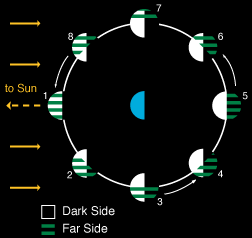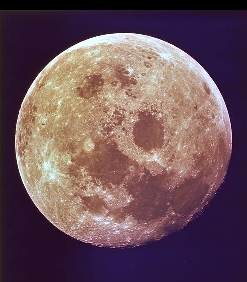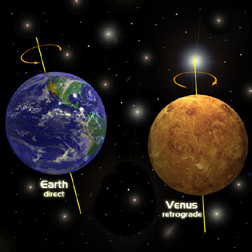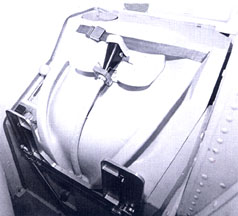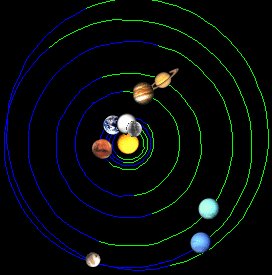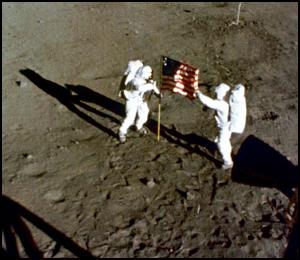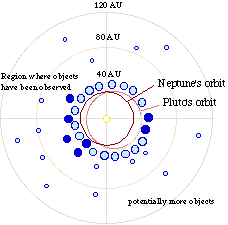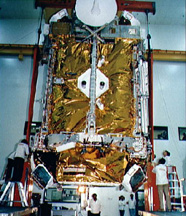Quickie Questions - Moon Madness - Movement of the Moon
| Date Answered | Questioner (age, location) | Question | Answer |
|---|---|---|---|
| December 17, 2009 | Jordyn (age 13, Michigan) | during which phase of the moon can a lunar eclispe occur? explain | An eclipse of the Moon (or lunar eclipse) can only occur at Full Moon, and only if the Moon passes through some portion of Earth's shadow. |
| December 17, 2009 | Widad (age 13, England) | What evidence do we have that the moon orbits the earth? | There are many, and one of the first known is the moon phases, which occurs due to the relative positions of the Sun, Earth and Moon. Now it is possible for the astronauts and instruments aboard space missions to observe the Moon motion around the Earth. |
| October 6, 2009 | keratam (age 25, India) | How does the Moon's orbit plane (disc) moves in the space along the year? Is it at the same position all year long with respect to stars like Earth's rotation axis? | The lunar orbit plane is inclined to the ecliptic by 5.1°. The rotation axis of the Moon is also not perpendicular to its orbital plane, so the lunar equator is not in the plane of its orbit, but is inclined to it by a constant value of 6.688°. See the section INCLINATION ON this page. |
| August 10, 2009 | Biyas (age 12+, India) | Whatis the duration of each rotation of moon? | The "rotational period" of an object is the amount of time it takes for the object to complete one turn, or rotate on its axis. The Moon rotational period, at 655.728 hours, is much slower than Earth. |
| May 11, 2009 | Damielina (age 12, New York) | what is the major force that keeps the moon in it's orbit around the earth | Any orbiting object moves under the action of two forces, the centripetal force (directed to the center), which in the case of the planets and other celestial objects is gravity, and the centrifugal force, tangent to the motionn. |
| April 30, 2009 | kbk (age 13, india) | moon having 1/6 gravitational force than that of the earth how is it able to stay in the sky why does it not get attracted and crash on the earth | Because its motion around the Earth balances out the atraction of our planet. The two forces involved are the centripetal force (in this case gravity), and the centrifugal force, which is tangent to any point of the lunar motion around the earth. |
| November 7, 2008 | jerald (age 29, usa) | at what rate does the moon orbit the earth? | It takes the Moon 27.322 days to go around the Earth once. Because of this motion, the Moon appears to move about 13° against the stars each day, or about one-half degree per hour. |
| May 28, 2008 | Lita (age 27, Yemen) | Does the moon have more than one orbit? | I am not sure what are you asking, but assuming it is related to the movements of the moon, the answer is yes. The moon, as the rest of the planets and moons in our system, moves around the Earth and rotates over its axis roughly at the same speed. And, of course, it also moves around the Sun! |
| March 10, 2008 | Stan Montgomery (age , ) | The tidal force exerted by the Moon on the Earth causes the oceans to bulge. The Earth rotates about its axis faster than the Moon revolves around the Earth, and this rapid rotation carries the tidal bulge of the oceans forward of the Moon in its orbit. So the tidal bulge on the Earth is always slightly ahead of the Moon's own position. This bulge is continuously tugging the Moon forward, increasing the Moon's total energy. For a more detailed answer, please visit this page. | |
| March 4, 2008 | lizzie (age 12, VIETNAM) | how many days does the moon take to rotate completely? | The "rotational period" of an object is the amount of time it takes for the object to complete one turn, or rotate on its axis. The Moon rotational period, at 655.728 hours, is much slower than Earth. In the time that it takes for the Moon to complete just one turn on its axis, the Earth will turn over 27 times! |
| February 13, 2008 | Binil (Morocco) | "Why does it take the moon 29 days to revolve and 27to rotate?" | The synodic period of the Moon is the time to complete a cycle of phases. This takes about 29.5 days—just over 4 weeks. The sidereal period of the Moon is measured relative to background stars and represents the actual time to orbit Earth once. This takes about 27 days. The difference between the periods is due to the fact that as the Moon orbits the Earth, the Earth orbits the Sun. The Moon must then revolve more than 360° to reach the same alignment for New Moon. Extra 29° takes an extra 2 days. |
| August 17, 2007 | Jeff | In short, the answer is yes, the moon also has a rotation and a revolution motions. Moon's rotation and revolution have the same period, so that the same side of the Moon is always facing us. In fact, most moons in the solar system have a similar synchronous orbit, caused by the tidal forces exerted on the moon by the planet. | |
| March 5, 2007 | Arshi (Ireland) | Why does the Moon seem to be Moving ,when seen from the Earth | Because it does! The Earth Moon moves around the Earth and rotates over its axis roughly at the same speed. The Moon rotational speed at its equator is about 10.3 mi/hr (or 16.7 km/hr). |
| February 5, 2007 | courtney (USA) | Which way does the moon rotate around the earth and why? | The moon appears to move east to west, as do all celestial bodies, due to the direction of the Earth's spin. |
| January 23, 2007 | star (florida) | what cuases the moon to change shapes (phases) throughout the month? | At any position, half of the Moon is illuminated by the Sun (the light side of the Moon) and half is not (the dark side). Also, half of the Moon is visible to the Earth (the near side of the Moon) and half is not (the far side). As the Moon moves around the Earth, we can see different fractions of the illuminated half of the Moon. A more detailed explanation, including a useful diagram, can be found at our page Phases of the Moon. |
| January 23, 2007 | star (florida) | what cuases the moon to change shapes (phases) throughout the month? | At any position, half of the Moon is illuminated by the Sun (the light side of the Moon) and half is not (the dark side). Also, half of the Moon is visible to the Earth (the near side of the Moon) and half is not (the far side). As the Moon moves around the Earth, we can see different fractions of the illuminated half of the Moon. A more detailed explanation, including a useful diagram, can be found at our page Phases of the Moon. |
| December 11, 2006 | Rachel (Wales) | Has the moon been moving away from the Earth since the begining of time? | The tidal force exerted by the Moon on the Earth causes the oceans to bulge. The Earth rotates about its axis faster than the Moon revolves around the Earth, and this rapid rotation carries the tidal bulge of the oceans forward of the Moon in its orbit. So the tidal bulge on the Earth is always slightly ahead of the Moon's own position. This bulge is continuously tugging the Moon forward, increasing the Moon's total energy. For a more detailed answer, please visit this page |
| June 20, 2000 | Charles (Massachusetts, USA ) | How long does it take the Moon to make one revolution around the Earth? | It takes the Moon 27.322 days to go around the Earth once. |
| July 7, 1999 | Kevin (California) | Why doesn't the Moon fall down? | Good question Kevin! The moon is actually falling all the time. Its just going so fast it never catches up to the Earth. This never ending falling is called orbital motion. |
| April 23, 1999 | Paige (Texas, USA) | I would like to know... what direction does the moon appear to move at night- east to west or west to east? | The moon appears to move east to west, as do all celestial bodies, due to the direction of the Earth's spin. |
| November 30, 1998 | Scott (New Jersey, USA) | Why does the moon orbit the earth in an elliptical path instead of just a circle? | The Sun's gravity pulls the Moon's orbit a little bit out of its circle into an elliptic path. |
| August 5, 1998 | Scott (Texas, USA) Joe (Age 46) |
Is the dark side of the moon always in darkness? Does it ever face the sun? What about during a solar eclipse? | The "dark side" of the moon is not always dark. The reason it is called the "dark side" is that that side of the moon is never visible from Earth. The moon's rotation and orbit are synchronized in such a way that we can only see one side. However, that "dark side" (or far side which is a more appropriate name!) does see the sun. For example, when we see only a sliver of the moon, most of the far side is facing the sun. During a solar eclipse, all of the far side is sunlit! |
| May 27, 1998 | Ty (South Carolina, USA) | How is it that the Moons rotation and revolution are the same? What are the odds? | It may seem quite a coincidence that the Moon's rotation and revolution have the same period, so that the same side of the Moon is always facing us. But in fact most moons in the solar system have a similar synchronous orbit, caused by the tidal forces exerted on the moon by the planet. |
| May 22, 1998 | Joseph (Pennsylvania, USA) | Why does the earth spin? I know that it has always been spinning, but what started it? Why does the moon not spin? Does it have to do with gravity? | Well, the answer to your question starts way back with the Big Bang. Matter spun off of this original explosion (much like water spins in smaller circles when you swirl your hand through it). The Earth and other planets continue to spin unless acted on by an outside force (a big comet hitting the planet, etc). The Moon actually does spin. It rotates just once as it orbits the Earth. This is the reason we always see one side of the Moon. |
| May 12, 1998 | Abbie (Spain) | In which direction does the moon rotate, clockwise or counterclockwise, and in which direction does the sun rotate? | The Moon and the Sun both rotate counterclockwise. They exhibit direct orbital motion (as opposed to retrograde) - or counterclockwise when viewed from the north pole of the celestial sphere. |
| March 3, 1998 | Connor | Why doesn't the moon keep on going in a straight line into the universe? And can you tell me how it was proven(if it has) that the earth doesn't orbit around the moon. | The reason the moon doesn't continue out into the universe is that the Earth exerts a pull on the moon, which keeps it orbiting the Earth. Since the Earth is so big compared to the moon, it pulls the moon toward it. In a sense, the moon is falling towards the Earth, but since the moon is also moving forwards, it ends up going around and around the Earth. The reason we know the Earth doesn't orbit the moon is that the Earth is so much bigger than the moon. The gravitational pull of the moon isn't enough to pull the Earth into its orbit. |
| February 17, 1998 | Salma (Egypt) | Does the moon rotate in an elliptical orpit or a circular one? | The moon's orbit around the Earth is almost circular, but not quite. So it is slightly eliptical. The moon's orbit along with the Earth around the Sun is just plain eliptical. |





